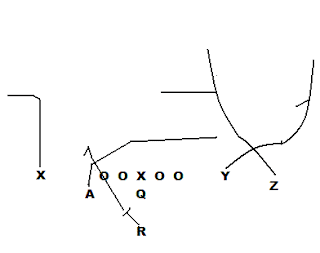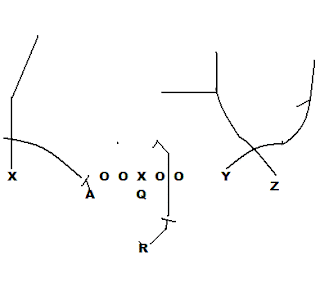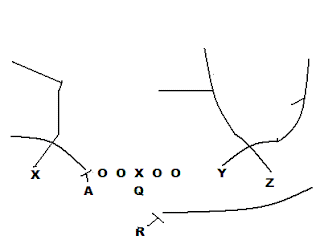But let it be known that Jones has adapted some aspects of the traditional Mouse Davis Run and Shoot to his liking, discarding some concepts, adapting others, and overhauling the pass protection. (Hence why my "What Killed the Run and Shoot" thread doesn't keep Jones up awake at night - they simply do different things now.)
In the traditional shoot, there were only a few pass packages, but each had multifarious adjustments for each receiver. They did this by requiring each receiver to identify the defense and each would adjust his route on the fly. The QB would synthesize this information and hit the proper man. As June Jones said when he was still in the NFL: "When our receivers run up the field, they are going to look for one of five coverages. A team may use 50 defenses, but to us it will be one of those five."
Those five coverages were: "(1) Three Deep Zone; (2) Two Deep Zone, (3) Two Deep Man Under; (4) Man Free [One safety deep with man-to-man underneath]; (5) Four Across Man (Blitz)."
Now, this was quite successful for many years. Without overemphasizing the impact, the rise of the zone blitz muddied the waters for many of these reads and hastened the R&S's retreat. I say I don't want to emphasize this too much, because the zone blitz has been around for at least as long as the Shoot, so it wasn't just that.
But there has been a definite trend among Shooters to reduce the number of reads that receivers must make. Even Jones has reduced the amount of reading in his offense and appears to have discarded a few of the concepts completely, while only adjusting others. And yet, the "reading" is what makes the Shoot the Shoot. So that is my topic today.
I have said many times that regardless of whether you see teams run the "Run and Shoot" per se (and I am talking about the "Run and Shoot" as a distinct system, not just a generic term for any ol' spread team), you will constantly see the R&S concepts and you will continue to see them for a long time. So in this post I want to discuss one of the most common and successful concepts, the Switch.
The Switch
The Switch is one of the Shoot mainstays, but the concept has transcended the offense and now chunks of NFL and College playbooks are dedicated to the "switch" - often from coaches who would otherwise show nothing but disdain for the now supposedly discredited offense. But to many coaches, players, and fans, the play is still shrouded in mystery.
The concept is, at core, a two man concept. Two receivers release and "switch": The outside guys angle inside for 5-6 yards before pushing vertical, while the inside guy runs a "wheel route" under the outside guy, rubs right off of his hip, and then turns up the sideline. That's when they play gets interesting.
In the original R&S, each receiver had the five delineated options depending on what coverage he saw. They could break it quick on slants, run vertical routes, post routes, curls or in cuts. When it worked it was beautiful. But sometimes, to borrow Yeats's phrase, "things fall apart." Or simply it took immense practice time for receivers to get good at running the play.
Indeed, it is simpler to teach this kind of thinking when all of your routes adjust. But it's not quite so simple if you run curl-flat as your bread and butter play, with no reading, as many teams do. And yet. the play thrives.
The Reads
Some coaches have installed the switch and simply eliminated the reads entirely. This is a sound approach, and it captures the initial beauty of the play: the "rub" the two switching receivers create against man. And it still works as a kind of "vertical stretch" where the two receivers can put deep defenders in a bind with one down the sideline and another in the seam, especially if a backside receiver runs in the seam as well.
But the play's potency is in its variance. And you can be variant without overly complex reads. How? Here is how I suggest running the play, as dithered from the best College, Pro, and High School minds who use this concept.
The Routes
Below is a basic diagram of the route.

The reads are as follows:
Inside Receiver: The inside receiver will come under the outside guy on his route, and wheel up the sideline. All he is looking for is whether there is someone deeper than him in the deep one-third of the field. Or, if the guy on him is playing him in man, he just asks: "He's even? I'm leaving! (Running deep) He goin? I'm stayin." It's as simple as deciding whether you could get open deep or not. If the defender stays deep, the receiver will stop at 10-12 yards and settle and curl back to the Quarterback.
Outside Receiver: The outside guy will stem his route inside and then push up the seam. His read is simple:
- Middle of the Field Closed (I.e. Is there a single deep safety in the middle of the field, like in Cover 3?) - Run a seam.
- Middle of the Field Open (I.e. Are there two deep safeties with no one deep down the middle?) - Run a square in at 12 yards.
I have previously described the nuances of this MOFO/MOFC read. Now, this might sound a bit tricky, but this is the one, core "reading" principle that any receiver can quickly identify both before and after the snap, and in most cases it is quite intuitive: don't run into coverage.
Below is the route against a few coverages to show how it would play out.
Cover 3

And Cover 2

QB Read:
The QB's read is not difficult. It is a pure progression read, though pre-snap and post-snap he will identify 2-high and 1-high so he knows what he's looking for. Against 1-high he will look at the F/S (deep middle safety's) movement. He will peek for the backside seam but read (1) inside switcher, (2) outside switcher, and (3) outlet to running back.
Final Concerns
One of the purposes of this article was to show that this concept, native to the Run and Shoot, can be run in many offenses. I have shown it so far in a very Shoot friendly formation. But do not be fooled: this route can be run by any two line of scrimmage receivers, in nearly any offense. See the diagram below with the Switch with play-action from the I formation. Again, you can run this from any formation you like.

And finally, if one did adopt to their offense (or you begin to notice it on television), there are further adjustments you can make. One of the long-time best has been the "Switch-Smash," shown below.

On this route the outside receiver stems inside and then pushes to 12 yards before running a corner route, while the inside receiver "wheels" out and pushes to 5-6 and then hitches back. He then delays briefly, and if the QB does not immediately deliver the ball, he will work to find the opposite spot or burst and lose his man to man defender. This is a great change up, particular against a team that runs Cover 2.
Grab-Bag
As a final parting shot, I will show you a few more variations with what you can do with this play. The concept is simple, so you can build on it or combo it as you like.








4 comments:
Excellent stuff. I've always been a fan of the old Dan Robinson combo from the Bunch Attack book where you match up the switch with an option route by #3. Also pretty good with a simple whip route by #3.
We have played around with the switch releases a lot and last summer even tried a deep 10-12 yard option route by the outside guy with the freedom to break in or out. The inside guy started on his wheel path and broke to the post. It was pretty cool but we never really fully explored it.
"He's even? I'm leaving! (Running deep) He goin? I'm stayin."
Took the words right out of my mouth. Certain matchups this applies immediately. The time it takes a player facing the LOS or QB to turn on a pass behind him that doesn't stay in the air too long and is thrown to a point he has to turn around entirely can be two or three steps on how players come out of breaks. If the corner watches the backfield too much he's burnt and then susceptible to play fakes for the game's entirety.
Read the corner technique to determine the route. Don't look back to the QB, just get your route full speed and determine ball location based on the throw that develops off what cover shows.
I call it the push, because the emphasis is on pushing the seams.
If they zone up and get over the routes you can settle into hook or curl routes.
Switches are automatic in our base offense because we used slot to start the year. We went spread on most passing downs and it develops the same way as the R and S.
You have the same feature shown in the 'final concerns' section, first photo.
I still prefer to run it play side to slot, give the TE the option over the middle on MOFO/seam or even a OCO/corner.
Then the front slot can push at the sideline or comes back and simply continues to run a drag route under for control passing.
That way a near certain completion works into ball control and keeps you in running and play pass situations, and the QB can flow out if mobile and work a give and go kind of feel. Hoops terminology really works well for instructing high tempo attacks.
Your smash is simply a vert hi-low coming off a rub. That should work best vs. zone or shell safeties, correct?
I call it a streak, four verts with post routes and deep crossing in on the backside and the deep in to the front side to work the usual stem read since we know the safety will be held to the seam.
The back runs the out on these and can still run the wheel/push a flag route.
It gets him a bit further upfield and gives the OLB a different look on his release, drives him further upfield off the flat so a running QB can develop additional space to read play depth or use his feet to move chains. That helps a crease route develop even better as well.
Something starts as four verts(man) turns into a zone killer with the in/curl(quarters or zone), backside post(two cover the safety gets out of position, one cover the safety flows), and the far wr running in all the way to middle field.
We run short ins in a way that flows with a play, either trailing or leading the roll-out for a give and go read. It makes for a great timing drill and works right into game play. The same technique then can apply to a deep in to the play side, it develops as a push clears.
Your smash route is already a part of our base sprint look. The low cross(switch look, slant and out) turns into the medium push on the seam, and at its deepest level turns into a play side hi-lo corner route, anticipating a low focus on the out, or rollout, or back release.
Your switch-smash, I thought applied to the backside looks(high cross) vs.low cross(switch).
Away side on slot we give the TE a corner read flattened under a high defender, the back works under him hi-low, and the slot does a shallow cross that enables a high/low middle read with MOFC post(2 or O), skinny post(cover 3) or in before a high MOFC across the safety's face. The quick crossing route forces the defender to commit early to accelerate the read for the MOFO and across the play side it becomes part of a triangle with the TE/RB going hi-lo front.
-Mr.M
For the pro looks I would prefer the primary route stay the same as the hot for short yardage routes.
That way you don't switch reads or progressions and can get the ball out quickly.
It appears the pats do that a lot. They did more so when Troy Brown was playing. Read outside-in with the same key hot. Quicker passes take pressure off the OL and QB.
Some of that appears to have changed with Welker's arrival, using the motion man as the hot/primary and the TE in the red zone.
The hot route should always be the same as the primary if you want to elimate pressure. The routes that change should be in zones, where you assume one gets time to throw and read through progressions.
Read routes vs. zone, hot routes stay primary.
Great article Chris.
Whatching the Charges Colts game I saw them run the switch route out of the I twins just as you drew it up for big yardage.
Post a Comment